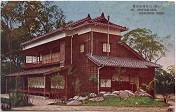|
The target readers of The Taiwan Shinminpo, upon becoming a daily, had gradually expanded from the elite to the literate mass, with the contents shifting from politics-centered to reader-oriented. Considering the keen competition in the newspaper industry, the daily increased its coverage on popular culture with more pages dedicated to entertainment and arts. A longtime column on the entertainment pages listed the radio programs and its title was changed from 「無線電台」(literally “Wireless Station”) to「ラヂオ」 (“Radio”) and eventually to 「今夜の放送」 (“Tonight’s Broadcast”) at the end of February 1943. Radio programs broadcast included talks, cooking, children's programs, music, radio dramas and so on. Depending on the space available, the program contents were briefly introduced, such as the speaker, outline of the talk and songs to be played. The entertainment pages also carried news about movies and popular artists, both local and foreign, as well as performing arts and music appreciation. Contents on the arts and literature pages included serial novels, literary criticism, travel notes, essays and poems. The “Chinese Poetry” column was the one that ran the longest and was published till end of February 1944. In addition to being a refined and elegant art, Chinese poetry was also a channel for literati to express their feelings and to vent their distress. In particular, against the backdrop of Japanese rule, poem composition became a wrestling field between the colonizer and the colonized. The poetry column had different titles over the years, including 「漢詩」(“Chinese Poetry”), 「心聲」(“Inner Voice”), 「詩」 (“Poems”) and 「興南詩苑」 (“Kounan Poetry Garden”) as well as 「自由詩」(“Free Verses”) and「曙光」 (“Dawn”) both of which carried readers’ contributions. Furthermore, to make the pages more authentic and eye-catching, they included photos and images of foreign scenery, folk customs, scientific machinery as well as the exhibits and reviews of the Taiwan Government-General Art Exhibition and the Tai Yang Art Exhibition, two important annual events in Taiwan’s art circle. (Figure 9)
Figure 9 Established in 1934, the Tai-yang Art Association is the fine arts group with the longest history in Taiwan. Every year, the Association organized an exhibition (Tai Yang Art Exhibition), offering a venue for painters to display their artworks. For several consecutive days, The Taiwan Shinminpo published artworks on display at the Tai Yang Art Exhibition of 1940. This image showed a painting titled “Over the Cool Autumn Water” by Kuo Hsueh-hu. On the same page were another painting by Yang San-lang and the serial novel Camellia by Chang Wen-huan. Source: The Taiwan Shinminpo No. 3322 (1940-04-28), Records of the Taiwan Shinminpo (T1119_02_100_0027).
In addition, to promote interaction with readers, the newspaper had designated columns that invited readers’ contributions. One such column was the 「揭示板」(“Bulletin Board”) (published till 1940/11). Readers could send in suggestions, questions and comments for anything, like sharing thoughts on the contents, inquiring the identity of anonymous writers, and asking for recommendation of books on topics. Contents of this column were diverse and down-to-earth, shedding light on how The Taiwan Shinminpo operated and what the readers thought of it. Another such column titled「身上相談」(“Personal Consultation”) (published till 1941/8) claimed to help readers in distress and offered consultation on life problems such as career planning, changing jobs, finding a partner, and mending relationships. Contents of this column revealed the social atmosphere and values at that time. For example, in The Taiwan Shinminpo No. 2549 (1938/10/10), a reader intending to marry someone two years older than he asked if there would any impact on their future generation? The newspaper replied that marrying an older woman would not have negative impact on their offspring but reminded the reader to be psychologically prepared that women aged more quickly due to childcare and housework and would appear much older after middle age. (Figure 10). Dr. Huang Chao-ching, a staff member of The Taiwan Shinminpo, took charge of the column「紙上病院」 (“Paper Hospital”) (published till 1941/9) and answered medical questions raised by readers who were required to provide personal details on gender, age, occupation, physical fitness, past medical history and current symptoms to facilitate Dr. Huang in giving appropriate advice.  Figure 10 This The Taiwan Shinminpo of March 11, 1938 carried the reader’s question on marrying an older woman in the “Personal Consultation” column at the bottom of the Entertainment and Arts page. Next to it was the “Bulletin Board” column with most questions posted related to entrance examination and admission qualifications and with comments on the unfair appointment of national high school principals and vice principals. Reply from the newspaper was marked by (係) (staff) in parentheses at the end. Source: The Taiwan Shinminpo No. 2549 (1938-03-11), Records of the Taiwan Shinminpo (T1119_02_075_0011).
The newspaper also had contents targeting housewives as readers, such as family finances, beauty care, medical and health care, parenting, cooking and fashion. Titles of these columns included 「家庭婦人」 (“Homemaker”),「家庭と趣味」(“Family and Fun”), 「教育相談」(“Educational Counseling”), 「家庭醫學」 (“Family Medicine”) and「生活文化」(“Living Culture”). While these titles had changed over the years, the contents remained to be topics of interest and concern to women and revealed the social expectations of women and motherhood as well as the evolution of parenting concepts during the Japanese colonial era. (Figure 11) With the reduction in news pages, these columns and contents were cut. By May 1943, only radio programs, movie show times, and serial novels remained on the Entertainment & Arts page.
Figure 11 This newspaper of April 5, 1939 had a family page with the “Homemaker” column which carried an essay published by the Japanese Institute for Science of Labor. It pointed out that housewives doing chores for long hours and with bad posture caused health damage, and offered tips for alleviating fatigue such as sweeping with long-handle brooms and raising the stove height. Source: The Taiwan Shinminpo No. 2936 (1939-04-05), Records of the Taiwan Shinminpo (T1119_02_088_0004). |
 |





